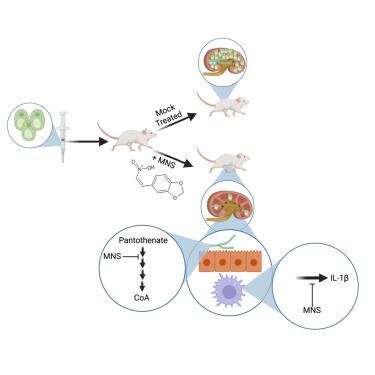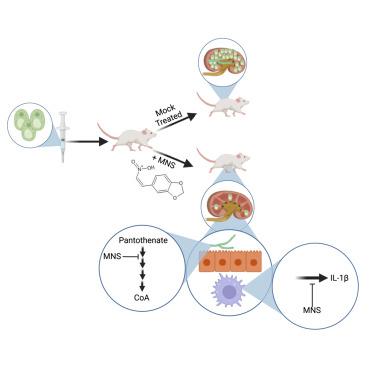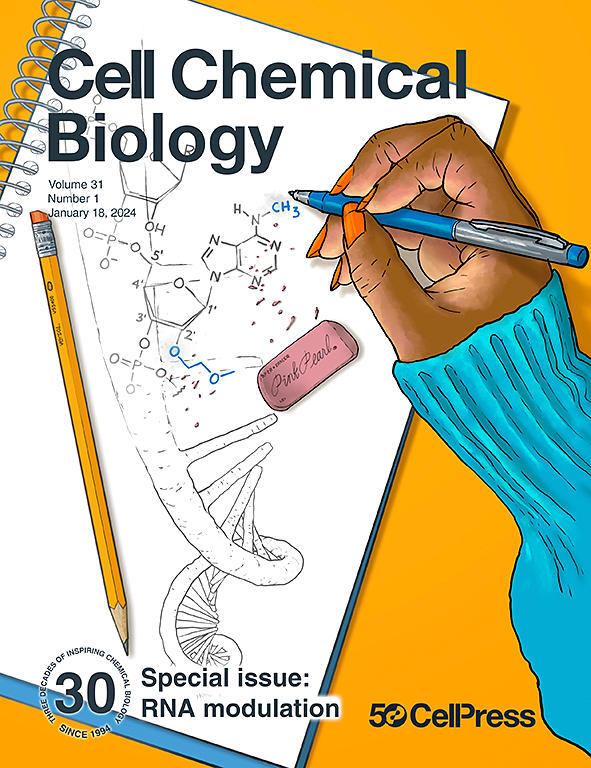泛酸激酶是抗真菌治疗的有效靶点
IF 7.2
1区 生物学
Q1 BIOCHEMISTRY & MOLECULAR BIOLOGY
引用次数: 0
摘要
泛酸激酶(PanK)催化泛酸转化为辅酶A (CoA)的第一步,辅酶A是所有生物体中必不可少的辅助因子。本研究的结果表明,PanK对哺乳动物宿主中两种最重要的医学真菌——致病性白色念珠菌和传染性烟曲霉——的生存能力和毒力至关重要。采用生物化学、生物物理和化学遗传学方法鉴定了3,4-亚甲基二氧基-β-硝基苯乙烯(MNS)是一种广谱抗真菌药物,可直接作用并抑制PanK以阻断CoA的产生。重要的是,MNS对哺乳动物PanK无活性,并在小鼠弥散性白色念珠菌感染模型中显示出体内抗真菌功效。因此,MNS提供了一个有价值的化学探针,以确定小分子抑制剂靶向PanK的有效性,作为开发有效抗真菌疗法的策略。本文章由计算机程序翻译,如有差异,请以英文原文为准。


Pantothenate kinase is an effective target for antifungal therapy
Pantothenate kinase (PanK) catalyzes the first step in the conversion of pantothenate to coenzyme A (CoA), an essential cofactor in all living organisms. The findings of this study demonstrate that PanK is essential for the viability and virulence of two of the most medically significant fungi—the pathogenic yeast Candida albicans, and the infectious mold Aspergillus fumigatus-within the mammalian host. Biochemical, biophysical as well as chemical-genetic approaches were applied to identify 3,4-methylenedioxy-β-nitrostyrene (MNS) as a broad-spectrum antifungal that directly engages and inhibits PanK to block CoA production. Importantly, MNS is inactive against a mammalian PanK and demonstrates in vivo antifungal efficacy a mouse model of disseminated C. albicans infection. Thus, MNS has provided a valuable chemical probe to establish the validity of targeting PanK with small molecule inhibitors as a strategy to develop efficacious antifungal therapeutics.
求助全文
通过发布文献求助,成功后即可免费获取论文全文。
去求助
来源期刊

Cell Chemical Biology
Biochemistry, Genetics and Molecular Biology-Molecular Medicine
CiteScore
14.70
自引率
2.30%
发文量
143
期刊介绍:
Cell Chemical Biology, a Cell Press journal established in 1994 as Chemistry & Biology, focuses on publishing crucial advances in chemical biology research with broad appeal to our diverse community, spanning basic scientists to clinicians. Pioneering investigations at the chemistry-biology interface, the journal fosters collaboration between these disciplines. We encourage submissions providing significant conceptual advancements of broad interest across chemical, biological, clinical, and related fields. Particularly sought are articles utilizing chemical tools to perturb, visualize, and measure biological systems, offering unique insights into molecular mechanisms, disease biology, and therapeutics.
 求助内容:
求助内容: 应助结果提醒方式:
应助结果提醒方式:


